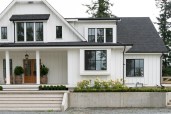Surveys Say While natural milled wood and finger-jointed stock still dominate the millwork market, materials including pultruded fiberglass (FRP) and wood-polymer composites (similar to engineered decking) are gaining market share and raising eyebrows among mill-work-category manufacturers, dealers, and builders. For the first time ever, the 2005 window and door industry forecast by Troy, Mich.–based Ducker Research considered fiberglass as a separate materials category based on double-digit sales gains from the year before; a similar industry study by Fry Consultants in Chicago reported that fiberglass and composites currently garner a 10 percent share of the window and door market, with sales growing at a 25 percent annual clip. But such findings don’t even consider how much of this new-age material is being used as component parts for mill-work products. By some estimates, perhaps half of the FRP purchased by the fenestration industry, representing a $200 million annual investment by 2009, is used for stile and threshold or sill stock, if then sheathed in PVC or another veneer. Meanwhile, fully one-third (or $1.2 billion worth) of composite wood stock is expected to be used for trim moldings by the end of the decade, according to research released by the Freedonia Group in Cleveland.
Tips for Millwork Operations Consider the following tips for a smooth-running and profitable millwork shop within an LBM operation:
- Integrate alternative materials, such as fiberglass and wood-polymer composites, into your mix to diversify your dependence on natural imports.
- Address a more competitive housing market with cost-efficient, low-maintenance millwork packages.
- Design and deliver exterior packages around particular and popular architectural styles in the area to create a cohesive look that boosts curb appeal and gains more of the millwork ticket.
- Offer a wealth of services, including design, shop drawings, estimating, and installation.
- Address local or regional climate conditions (and common problems they cause) with logical, low-cost fixes.
- Keep an eye on material and design trends and look for sources that enable you to quickly meet demand.

